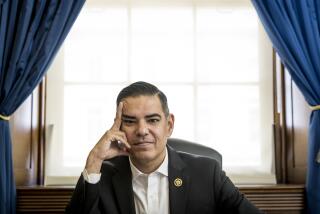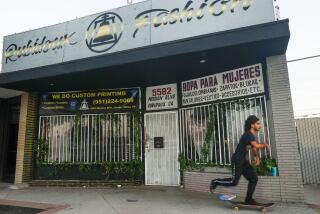Can One Hero Ease Bias About Who Commits Crimes?
It was the perfect media crime, made for the 6 o’clock news.
Murder at the mall. A crazed man attempts a midday carjacking two weeks ago at the South Bay Galleria in Redondo Beach. He pounces on his helpless victim as she tries to flee, stabbing her as stunned shoppers watch. When the killer attempts to walk away, two workers reportedly catch and hold him for police.
What a relief. No killer on the loose. No composite drawings required. Was he white, black or Latino? Did he have a broad nose, thin lips, dark or pale skin? Nobody had to ask.
Thanks to those two heroes, news reports said, police had their suspect, Joshua Daniel Lee, troubled young member of a well-known Hawthorne family. He was white like his victim, a beloved Brentwood grandmother named Diane Sims Bragg.
So race didn’t matter this time. In most news reports about violent crime, blacks and Latinos are the usual suspects. In this case, they were bystanders at a suburban mall that has drawn more and more minority patrons during the last decade.
Lee smiled during his arraignment, then hanged himself in jail 10 days after the attack. A ghastly epilogue. The media move on.
So the public never heard about the third hero on that day. David Garcia Sr. also took action to apprehend the killer. But he never made the papers or evening news.
Last week, the 49-year-old mover and ex-Marine was quietly honored for his bravery, along with Jason Campbell and Greg McCorkell, the two workers widely praised in the press. The trio received commendations from the Redondo Beach City Council during a tribute that wasn’t even covered by the local daily newspaper.
“Heroism like this in civic involvement has to be recognized,” said Mayor Gregory Hill as he shook hands with the three men. “You’re a tribute to the society, and we thank you for all you did.”
I don’t know how the press overlooked Garcia, a native of New Mexico and resident of Los Angeles. The killer apparently identified him to police as one of the men who had held him: Garcia was the guy wearing the FBI shirt.
A father of six adult children, Garcia was never in law enforcement. The FBI shirt was a gag gift from his wife. In small letters, it reads “Female Body Inspector.” But the killer only focused on the large initials, Garcia told me last week. He’s convinced the suddenly compliant suspect thought he was an agent. Lee even confessed on the spot, telling Garcia he had stabbed the woman because “she didn’t take me seriously.”
Garcia was having lunch with his wife when the commotion started. He ordered the fleeing suspect to stop and gave chase, catching up just as one of his fellow heroes pushed Lee from behind, knocking him down.
“Take it easy, man,” Garcia told Lee. “It’s all over with.”
In crime stories, Garcia is the exception. He’s the “antipredator” who smashes stereotypes of Latinos as gangbangers, robbers and rapists. But is he the exception that proves the so-called rule?
I am besieged by readers who dare me to “account for the horrendous crime rate that is prevalent with your ethnic group,” as one Irvine man put it. “It seems like every day there is a newspaper article describing someone with a Latino name who is arrested for some vicious crime.”
Readers clip out articles, underline the perps’ Spanish surnames, then send me the scrapbook as proof of their world view. I fear such people could never be talked out of their biases by isolated stories about good people like David Garcia.
“Would you really expect one story to change the drip, drip, drip of water torture that is the local news?” asks UCLA political science professor Franklin D. Gilliam Jr., an expert on how the media portrays crime and race.
Such heroic exceptions can actually reinforce stereotypes by reminding people that minorities are normally cast as perpetrators, not heroes, in the everyday “crime script” of the evening news, said Gilliam, director of UCLA’s Center for Communications and Community (https://www.sscnet.ucla.edu/issr/ccc/).
Garcia recalled several people who helped on that horrible day--an older white man, a Mexican worker, a doctor and two witnesses, an African American man and an Asian woman, who gave statements to police despite their obvious fears.
“Each one of us did something,” Garcia said. “Of course, at that moment, we didn’t have any race. It was a reaction that was human.”
And why did he act?
“Responsibility is another word for happiness,” Garcia said. “The lowest form of life is the state of apathy, and then after that is death.”
*
Agustin Gurza’s column appears Tuesday. Readers can reach Gurza at (714) 966-7712 or [email protected]
More to Read
Sign up for Essential California
The most important California stories and recommendations in your inbox every morning.
You may occasionally receive promotional content from the Los Angeles Times.










